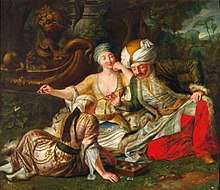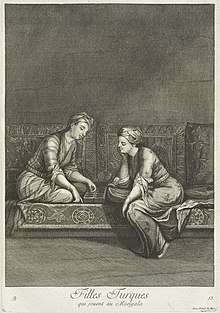Mangala (game)
Mangala is a traditional Turkish mancala game. [2] It is strictly related to the mancala games Iraqi Halusa, Palestinian Al-manqala, and Baltic German Bohnenspiel. There is also another game referred as Mangala played by the Bedouin in Egypt, and Sudan, but it has quite different rules.


| Mangala | |
|---|---|
| Ranks | Two |
| Sowing | Single lap |
| Region | Turkey |
The game can be traced in Ottoman miniatures starting from the 16th century.[3] According to the Turkish ethnologue Metin And, the "mancala" of The Arabian Nights (fifteenth night) could be directly related to this game.[4] It was first described in 1694 by British orientalist Thomas Hyde.[5] The game was also referred as Mangola in some later western works.[6]
The classic mangala game is still known in Turkey, but mangala played in Gaziantep, in Southern Anatolia, is more similar to Syrian mancala La'b Madjnuni (Crazy Game). There are many other mancala variants played in Anatolia: Pıç in Erzurum, Altıev in Safranbolu, Meneli Taş in Ilgın, etc.[7]
Rules
Mangala is played on a 2x6 (or 2x7) mancala board (i.e., 2 rows of 6 or 7 pits). At game setup, 5 pieces are placed in each pit. At their turn, the player takes all the pieces from one of their pits and drops them one at a time into the following pits counterclockwise. If the last piece in a distribution is dropped in a pit that contains 1 or 3 pieces (2 or 4 with the one just dropped), all those pieces are captured by the player. Also, if there is a continuous line of pits with either 2 or 4 pieces before the one where the capture has occurred, all the seeds in those pits are captured as well. Players may capture on either side of the board. The game ends when all the pits are empty. The player who captured most pieces wins the game.
References
- Vanmour, Jean-Baptiste (1714). "Filles turques qui jouent au mangala". Recueil de cent estampes representant differentes nations du Levant.
- Arslan Küçükyıldız, Türk Zekâ Oyunları-1; Köçürme-Mangala. Ankara. Delta Kültür Yayınevi, 2016, 304 sf
- "History of Mangala". Archived from the original on 10 August 2011. Retrieved 2 September 2011.
- M. And. "Some Notes on Aspects and Functions of Turkish Folk Games". The Journal of American Folklore, vol.92, No. 363 21, p. 44-64, 1979. Retrieved 2 September 2011.
- T. Hyde, De Ludis Orientalibus, 1694, Oxford (England), p. 226-232.
- Jean Antoine Guer. "Moeurs et usages des Turcs, leur religion, leur gouvernement civil, militaire et politique" (in French). Paris, vol.1, p. 394, 1747. Retrieved 2 September 2011.
Le Mangola est un jeu Turc , qui se joue avec de petites coquilles.
- M. And. "Çocuk Oyunlarının Kültürümüzde Yeri ve Önemi, 1979" (in Turkish). Ulusal Kültür - Üç Aylık Kültür Dergisi, No.4. Archived from the original on 21 May 2014. Retrieved 2 September 2011.